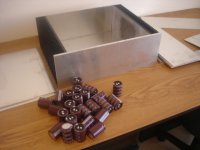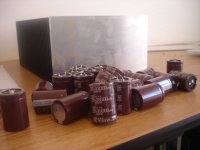If you choose your heatsinks with a bit of forethought, the case will design itself.
None of us, well very few, want a Nelson Pass Amplifier that looks like an afternoons collection of aluminium and loads of nuts and bolts.
My Metal Workshop consists of a couple of wooden blocks and a Hand Drill.
I opted to build the entire amplifier into an aluminium frame, just pices of 10mm aluminium held together by 50x50x5mm aluminium angle. The bottom is 10mm aluminium plate and tyhe top is 3mm aluminium plate. As a box it looks pretty good but I wouldn't want it in prime position in the lounge. Nor would it dissipate enough heat.
Spraying the top and bottom black and surrounding the chassis with 4 C/Watt heatsinks makes a finished product that is not too far off the original.
I am limited to a height of 250mm for my design, so I have opted for 190mm heatsinks to allow adequate airflow.
I reckon the Duo-Block (ie two mono-blocks in one case) will run at about 60 - 70 degrees.
None of us, well very few, want a Nelson Pass Amplifier that looks like an afternoons collection of aluminium and loads of nuts and bolts.
My Metal Workshop consists of a couple of wooden blocks and a Hand Drill.
I opted to build the entire amplifier into an aluminium frame, just pices of 10mm aluminium held together by 50x50x5mm aluminium angle. The bottom is 10mm aluminium plate and tyhe top is 3mm aluminium plate. As a box it looks pretty good but I wouldn't want it in prime position in the lounge. Nor would it dissipate enough heat.
Spraying the top and bottom black and surrounding the chassis with 4 C/Watt heatsinks makes a finished product that is not too far off the original.
I am limited to a height of 250mm for my design, so I have opted for 190mm heatsinks to allow adequate airflow.
I reckon the Duo-Block (ie two mono-blocks in one case) will run at about 60 - 70 degrees.
Anyone following the build of my Aleph4. I have now completed the chassis and attached the heatsinks.
I'm trying to get a decent quote for cutting cooling slots in the top and bottom covers, if not it will be out with the Jigsaw and some good British luck, along with good weather.
I hope that the image is a reasonable size this time and not 2.1MB.
I'm trying to get a decent quote for cutting cooling slots in the top and bottom covers, if not it will be out with the Jigsaw and some good British luck, along with good weather.
An externally hosted image should be here but it was not working when we last tested it.
I hope that the image is a reasonable size this time and not 2.1MB.
Andy5112405, nice job! Why don't you start an "Aleph 4 build thread" so that we can all follow your progress (rather than using the pics thread, which is mostly finished projects)?
I like the fact that you are applying lots of elbow grease vs. using a fancy machine shop.
I like the fact that you are applying lots of elbow grease vs. using a fancy machine shop.
When the project is complete I will look into posting the entire build as a thread. This one has really been an excercise in luck, hence the extremely low build cost. I hope that Nelson himself will agree that the build quality has not been compromised. I would have preferred larger transformers but 2 x 500VA are adequate.
No wasted real estate here. Possibly an improvement on the original, even if it may run slightly hot.
I've mounted the Input and Ouput sockets on the panel that would normally have the eighth heatsink attached.
I've mounted the Input and Ouput sockets on the panel that would normally have the eighth heatsink attached.
An externally hosted image should be here but it was not working when we last tested it.
Would be a fun contest to have. Pick a Pass amp or First Watt, and everyone makes the cheapest version they can that's not compromised to be worse than a commercial version of the same. I would predict a lot of pots and pans being used for heat sinks! Surplus and E-bay allowed.. But not stuf you have "Laying around" You would need receipts..
Of course looks could also be judged- Balancing cost and appearance..
well - something tells me that is hard to beat "Papa's Surprise" amp

few Donuts , few chokes for choke input PSU , few cans ......... everything from shelf
that's all I need to finish best looking amp


Case building
Ok I thought I would post some pictures of my case building efforts. I have cut up enough aluminium so that I can quickly switch between either two wide cases or two narrow cases (ie two stereo cases or two monoblock cases)
Ok I thought I would post some pictures of my case building efforts. I have cut up enough aluminium so that I can quickly switch between either two wide cases or two narrow cases (ie two stereo cases or two monoblock cases)
Attachments
Last edited:
I'm surprised at your choice of capacitors for a Class A amplifier.
I'm using 12 x Dubilier Computer Grade 33000uF / 75V caps which actually test at nearly 90000uF each. This gives me approximately 300000uF per supply rail and nearly 150A of ripple current. I bought them on E-Bay from the US and paid about £6.00 each for them.
I'm using 12 x Dubilier Computer Grade 33000uF / 75V caps which actually test at nearly 90000uF each. This gives me approximately 300000uF per supply rail and nearly 150A of ripple current. I bought them on E-Bay from the US and paid about £6.00 each for them.
Nelson is happy using Panasonic tsha. So I am happy using Nippon Chemi-Con KMH.
On top of that I got them very cheap (less than a dollar each).
On top of that I got them very cheap (less than a dollar each).
Last edited:
In my first prototype, my heatsinking was just completely inadequate and I cooked the output devices on one channel.
This case has now been scrapped and the components re-used.
This case has now been scrapped and the components re-used.
An externally hosted image should be here but it was not working when we last tested it.
Personally I would just check the maximum ripple current. Computer Grade Caps are generally HIGH ripple.
There is a very good argument for using LOTS of smaller caps. I've seen a Gain Clone project with over 100 x Black Gates.
I'm using B&W speakers which do require a high current drive, therefore my PSU is designed to give just that. In the Aleph 4 I can happily peak over 150A if the situation desires it.
There is a very good argument for using LOTS of smaller caps. I've seen a Gain Clone project with over 100 x Black Gates.
I'm using B&W speakers which do require a high current drive, therefore my PSU is designed to give just that. In the Aleph 4 I can happily peak over 150A if the situation desires it.
In the Aleph 4 I can happily peak over 150A if the situation desires it.
I do not remember the specs of the Aleph 4 but I am almost certain the Aleph current source would be lucky to deliver 20A/channel (in the Aleph 4) let alone 150A.
If you had a push pull output stage then that is a different matter (eg BA2). From memory the Aleph current source is limited to around twice the bias current. Eg If the bias current is 4A then the maximum output the Aleph current source will deliver is around 8A (could be a bit higher).
Obviously you could tweak the Aleph current source to put out a higher dynamic current, if that is what you wanted to do.
Last edited:
Personally I would just check the maximum ripple current. Computer Grade Caps are generally HIGH ripple.
Just cheked the data sheet. The ripple current is 5.39A per cap.
I am not sure how many I will use at this point in time. It will come down to listening tests.
I have 24, so I could use up to 6 per rail per channel (if I decide to go monoblock).
In the end the ear will decide.
Andy, your amp in picture looks real nice
yet, a small note about transistor mount
transistors should ideally be mounted around middle of heatsink, or even better right below, vertically
to me it appears like you have them very close to top of heatsink
yet, a small note about transistor mount
transistors should ideally be mounted around middle of heatsink, or even better right below, vertically
to me it appears like you have them very close to top of heatsink
Just cheked the data sheet. The ripple current is 5.39A per cap.
I am not sure how many I will use at this point in time. It will come down to listening tests.
I have 24, so I could use up to 6 per rail per channel (if I decide to go monoblock).
In the end the ear will decide.
Aren't there also arguments for not using an unlimited number of caps? In chip amps, which require less power smoothing, it is quite common to use as little as 4,000uF per channel, the argument being that it increases the audible speed (immediacy) of the amp without losing bass. Obviously that is a different situation, but isn't there an argument to say that too much capacitance might slow a Class A amp down?
Opamps generally have a much better PSRR than Class A amps if my memory serves me correctly. Therefore requiring less capacitance.
Obviously that is a different situation, but isn't there an argument to say that too much capacitance might slow a Class A amp down?
I would rather suspect that about very big supply caps, and Im not sure its only related to capacitance
Though, with classA, if caps are under rated they might get VERY hot
I doubt there are any simple single answers to that
- Home
- Amplifiers
- Pass Labs
- Pictures of your diy Pass amplifier


